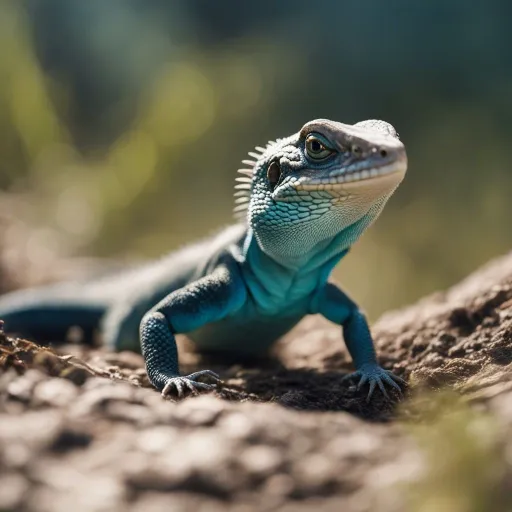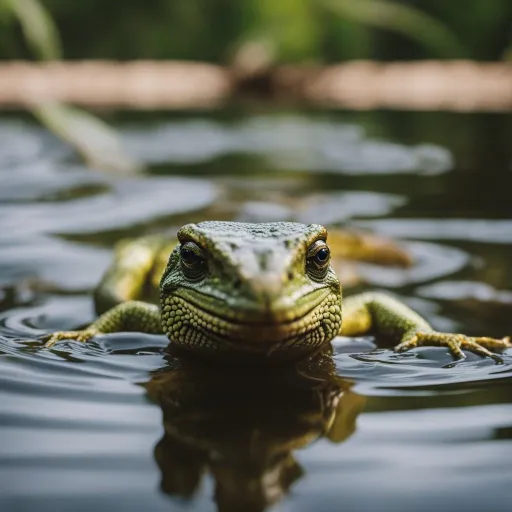
So you’re out exploring the great outdoors and stumble upon a vibrant and agile creature known as the blue belly lizard.
But before you dare to get too close, one question races through your mind – do blue belly lizards bite?
In this article, we will uncover the truth behind the sharp teeth of these elusive reptiles and explore whether you should be cautious or fearlessly approach them during your adventures in the wild.

Identification of Blue Belly Lizards
Blue Belly Lizards, also known as Western Fence Lizards, are small reptiles that can be found in various areas of North America.
They are easily recognizable by their vibrant blue bellies, which give them their common name.
These lizards have distinct physical characteristics and can be identified based on their appearance, distribution, and habitat.
Physical Appearance
Blue Belly Lizards have a slender body with a length ranging from 2.75 to 5.25 inches.
Their overall coloration varies depending on their environment, but their standout feature is the blue coloration on their bellies, which extends to their throats and sometimes down the sides of their bodies.
The rest of their body is usually brown or gray, helping them blend into their surroundings.
Their rough skin is covered in small scales, and they have a series of vertical lines running down their back.
These lines often have spots of a darker shade, creating a striped pattern. Blue Belly Lizards have long tails that are typically longer than their bodies and can be easily shed as a defense mechanism, a topic we will discuss later.
Distribution and Habitat
Blue Belly Lizards are primarily found in the western regions of North America, ranging from Oregon and Washington in the north to Baja California in the south. They can often be spotted in open areas such as grasslands, deserts, and foothills, where there is plenty of sunlight and low vegetation. These lizards prefer habitats with a mix of rocky areas and shrubs, as they provide both basking spots and places to hide.
Blue Belly Lizards’ Behavior
Understanding the behavior of Blue Belly Lizards can help us better appreciate these reptiles and interact with them safely. From their diet and feeding habits to their social behavior and mating rituals, let’s dive deeper into the intriguing behaviors of these fascinating creatures.
Diet and Feeding Habits
Blue Belly Lizards are insectivorous, meaning their diet primarily consists of insects. They have a broad appetite and can consume a variety of small invertebrates such as ants, beetles, spiders, and grasshoppers. These lizards are active hunters and rely on their excellent vision to locate their prey. Once they spot their target, they launch into quick bursts of speed, capturing their prey with their sharp teeth.
Social Behavior
While Blue Belly Lizards are primarily solitary creatures, they can sometimes be observed basking in groups to take advantage of the warmth provided by the sun. However, these gatherings are temporary, and each lizard maintains its personal territory. Males, especially during the breeding season, may become territorial and defend their chosen area from rival males.
Reproduction and Mating Habits
During the mating season, usually occurring between April and June, male Blue Belly Lizards engage in vibrant displays to attract females. They bob their heads, extend their dewlaps (throat fans), and perform push-ups to showcase their strength and dominance. Once a female is impressed by a male’s display, mating occurs.
Female Blue Belly Lizards lay a clutch of eggs, usually ranging from 8 to 14, in a carefully chosen location where the eggs can benefit from the warmth and protection offered by the surrounding environment. Incubation typically lasts for around 2 months, after which the hatchlings emerge.
Defense Mechanisms of Blue Belly Lizards
Blue Belly Lizards have developed various defense mechanisms to protect themselves from predators and other potential threats. Two notable defense mechanisms are tail autotomy and camouflage/coloration.
Tail Autotomy
When faced with imminent danger, Blue Belly Lizards have the ability to shed their tails. This process is known as tail autotomy. By voluntarily detaching their tail from their body, the lizards create a distraction that confuses predators, allowing them to escape.
The detached tail continues to move and twitch, further drawing the predator’s attention away from the lizard’s body. Over time, the tail will regenerate, although it may not have the same length or pattern as the original.
Camouflage and Coloration
Blue Belly Lizards use their camouflage and coloration to blend into their surroundings and avoid detection. The brown or gray coloration on their bodies allows them to camouflage effectively with the rocks, dirt, and vegetation in their habitats. This helps them remain hidden from predators and increases their chances of survival.
The vibrant blue coloration on their bellies serves a different purpose. When threatened or frightened, Blue Belly Lizards often exhibit their blue bellies by lifting their bodies off the ground, hoping to startle their predators. The sudden display of bright blue can potentially intimidate or confuse predators, giving the lizards an opportunity to escape.
Common Misconceptions about Blue Belly Lizards
Like many animals, Blue Belly Lizards have been subjected to various misconceptions and misunderstandings. Let’s debunk one of the common misconceptions associated with these reptiles.
Aggression and Bite
Contrary to popular belief, Blue Belly Lizards are not aggressive towards humans. They are generally known to be shy and will usually flee when encountered by loud or sudden movements. Their main priority is to avoid confrontation and seek safety.
Blue Belly Lizards’ Bite Potential
While Blue Belly Lizards are not aggressive towards humans, it is worth understanding their bite potential in case of accidental interactions. Although severe bites from Blue Belly Lizards are rare, it’s essential to know about their bite force and any potential venomous properties.
Bite Force and Venomous Properties
Blue Belly Lizards have relatively small mouths and teeth, and their bite force is not strong enough to cause any significant harm to humans. Their diet mainly consists of insects, so their teeth are adapted for grasping and holding onto small prey items rather than causing injuries.
Additionally, Blue Belly Lizards are not venomous. They do not possess any venom glands or venomous properties in their saliva, making their bites harmless from a venomous perspective.
Rare Instances of Bites
While bites from Blue Belly Lizards are rare, certain conditions or circumstances may lead to defensive bites. For example, if a Blue Belly Lizard feels threatened or cornered, it may resort to biting as a last line of defense. It is essential to remember that bites from these lizards are usually minimal and rarely result in any considerable harm.
Interactions with Humans
Blue Belly Lizards can be fascinating creatures to observe but should be respected and appreciated from a distance. Here are a few considerations when it comes to interactions with these reptiles, including their potential as pets and how to prevent bites.
Blue Belly Lizards as Pets
Blue Belly Lizards are not commonly kept as pets, primarily due to their specific environmental requirements and specialized care needs. These lizards thrive in their natural habitats, where they have ample space to explore, bask, and hunt for food. Attempting to keep them as pets can be challenging and not recommended unless you are equipped with the necessary knowledge and resources to provide a suitable and enriching environment.
Prevention of Bites
To prevent bites or unnecessary disturbances, it is crucial to observe Blue Belly Lizards from a safe distance. Avoid trying to handle or provoke them, as this can lead to defensive behaviors, including biting.
If you encounter a Blue Belly Lizard in your garden or natural habitat, simply appreciate its presence from afar. Admiring their natural behaviors and camouflaged beauty can provide an enriching experience without the need for direct contact.
Understanding Blue Belly Lizards’ Behavior
By observing Blue Belly Lizards from a safe distance, we can learn valuable information about their behavior and ensure their well-being. Let’s explore two key aspects of understanding their behavior: observing from a safe distance and interpreting defensive behaviors.
Observing from a Safe Distance
The best way to learn about Blue Belly Lizards’ behavior is to observe them in their natural environment without disturbing their routine. Find a comfortable spot where you can quietly watch their interactions, feeding habits, and basking behaviors. Use binoculars or a camera with a zoom lens for a closer look.
Avoid sudden movements or loud noises that may startle or cause distress to the lizards. Patience and respect are essential when observing these fascinating creatures.
Interpreting Defensive Behaviors
Blue Belly Lizards have distinct defensive behaviors when they feel threatened. Understanding these behaviors can help us interpret their stress levels and avoid unnecessary conflict. Some defensive behaviors include:
- Tail autotomy: If a Blue Belly Lizard senses danger, it may quickly shed its tail as a means of distraction and escape.
- Lifting of the body: When startled or threatened, Blue Belly Lizards may lift their bodies off the ground, showcasing their vibrant blue bellies in an attempt to intimidate or confuse predators.
- Hissing or opening the mouth: In some instances, Blue Belly Lizards may hiss or open their mouths wide as a way to display aggression or warn potential threats.
By recognizing and respecting these defensive behaviors, we can ensure the safety of both Blue Belly Lizards and ourselves.
Final Thoughts
Blue Belly Lizards are fascinating reptiles with unique characteristics and behaviors. Their physical appearance, distribution, and habitat provide insight into their natural lifestyle.
Understanding their behavior, including diet, social interactions, and defensive mechanisms, helps us appreciate and interact with these reptiles responsibly.
While Blue Belly Lizards are generally harmless and not aggressive towards humans, it is essential to observe them from a safe distance and avoid any unnecessary disturbances.
By respecting their natural habitat, avoiding attempts to keep them as pets, and interpreting their defensive behaviors, we can coexist with these beautiful creatures and continue to marvel at their unique blue bellies.



